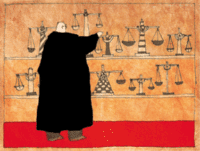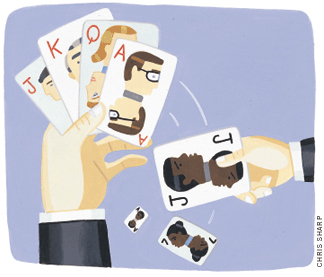
In the American criminal-justice system, the figure of Justicia is usually depicted wearing a blindfold. While that may symbolize an admirable impartiality, says Dr. Lawrence Sherman, it may also indicate an unwillingness to learn—and to take into account human emotions: of victims, of criminal-justice officials, and of criminals.
Blind justice, in other words, is not always very enlightened.
“I contrast the idea of blind justice, which purposively ignores the effects of the punishment it imposes, with smart justice, which seeks out that information and constantly uses punishment to achieve the safest society with the maximum liberty possible,” says Sherman, director of the Fels Center of Government and the Jerry Lee Center of Criminology, as well as the Albert M. Greenfield Professor of Human Relations. “What we’re really talking about is the difference between smart justice and dumb justice.”
In a recent keynote address to the American Society of Criminology (of which he is currently president), he defined “emotionally intelligent justice” as the “explicit recognition and management of the effects of emotions in causing the behavior of both officials and offenders.”
“The intention of modern criminal procedure—to minimize the presence of emotion in court for the purpose of assessing evidence about guilt—was entirely honorable,” he explains in his office in the Fels Center. “But once guilt is no longer an issue, there are huge emotional issues to be addressed. The court is institutionally incapable of addressing and processing emotions in a constructive way.”
But today, criminology is “poised for reinventing justice to focus on the emotions of victims, offenders, and society as the key to preventing crime,” he noted in his ASC address. “The growing costs and failures of deterrence, especially for socially excluded populations, create a window of opportunity for criminology to provide radical, bio-socially informed, emotionally intelligent alternatives to imprisonment.”
Consider, for example, the notion of Restorative Justice, which brings victims of crime face-to-face with offenders in carefully supervised meetings. In one major study that Sherman co-directed in Canberra, Australia, Restorative Justice meetings between victims and offenders were shown to reduce recidivism after violent crimes by 41 percent. Furthermore, by addressing the emotions of victims, the process helps “reduce their trauma and their desire to harm offenders.”
“Our strongest empirical evidence so far is that Restorative Justice works to help victims, regardless of the effect it has on offenders,” says Sherman. “And now that we’re testing it with very serious crimes in England, we’re getting more and more examples of victims whose traumatic stress was so severe that they were unable to function until they went into face-to-face justice with the offender. With the support of the community of concern, on both the offender side and the victim side, they were able to reach closure on the event, and to get their lives back. That’s what court does not do!”
Contrary to expectations, the Restorative Justice approach proved to be far more effective for violent crimes than property crimes.
“Everyone was surprised,” says Sherman. “What was generally thought was that Restorative Justice would be appropriate for less serious crimes. What we’ve been finding is that it has its best effects on violent crimes, and sometimes backfires on property crimes.”
Asked to explain that difference, he responds: “Our best guess is that offender empathy for victims really matters. While offenders may not empathize much with someone who has more property than they do, everyone suffers the same from physical pain. Many offenders have been the victims of violence themselves, and can identify with the harm that their own victims have suffered. So when the offenders meet with the victims for two to three hours to hear about the pain they have caused, they may get an epiphany about not wanting to do unto others something that is so painful. This may not work with psychopaths, but most offenders seem quite capable of feeling such remorse, based on putting themselves in the victim’s shoes.”
Another approach for making emotions “central to justice” is the wider use of biomedical mental-health treatments for offenders. One analysis of studies on patients on Prozac and placebo pills, Sherman notes, “found that the rate of violent or aggressive incidents reported among patients taking Prozac was 75 percent lower than it was in the placebo group.” The implications for violent offenders are obvious.
While many liberals have a “knee-jerk horror of the use of pharmacology to deal with crime,” he says, “when we think of the horrors of rape in prison—and indeed of capital punishment—we can ask what’s the lesser of evils.
“The key issue for pharmacology is voluntary consent,” he adds. “Schizophrenics are well known to not take their pills when they’re out in the community, and sometimes they commit violent crimes when they don’t. So one of the more interesting bio-social questions in criminology today is whether the use of conscience-building social treatments, such as face-to-face justice conferences, can increase the commitment by offenders to taking their pharmacological interventions that will help them regulate their own behavior.”
Another example of emotionally intelligent justice involves efforts to make justice officials more aware of the “emotional impact of their words on citizens.” While that may strike the cynical as touchy-feely and na�ve, Sherman points out that a recent study in Milwaukee found that immediately after offenders had been arrested for battering women, “those who had police listen to their side of the story during the arrest process had much lower repeat-offending rates over the next six months than those whose police officers didn’t listen to them.”
More important still was whether the offender lived in a high-unemployment neighborhood or was personally unemployed, notes Sherman. “This is where one size clearly does not fit all, because offenders who are unemployed or are in poverty areas tend to become much more violent against women because they’ve been arrested, as opposed to offenders who live in high-employment areas or who have jobs themselves, who are in fact less likely to re-offend if they get arrested than if they just get warned.”
Sherman is a strong proponent of evidence-based research [“A Passion for Evidence,” March/ April 2000], and he would like to see the criminal-justice system follow the scientific lead of medicine. “Doctors don’t give the same medical treatment to everybody” who has a certain illness, he points out; instead, they look at “all kinds of conditions, including allergies, in trying to decide what’s going to work best for that patient.” Medicine’s first principle—“Do no harm”—should be the model for criminal justice, he argues. Instead, the approach has been: “This is going to hurt me more than it will hurt you, but I have to punish you—because it’s my duty to punish.”
“Somehow in justice we think it’s immoral to do anything other than ‘one size fits all,’ even at the price of causing all this harm to victims,” he adds. “To say it’s immoral is to say victims don’t matter. It’s not just about offenders. It’s also about victims —and potential victims—and what works to minimize victimization ought to be front and center to the whole criminal-justice system. Right now, it’s not.”
It may be a hopeful sign that American citizens are almost universally disenchanted with the criminal-justice system. A 1998 poll of 4,000 people in the northeastern U.S. found that just 15 percent approved of the current criminal-justice system, while 75 percent wanted to revamp the entire system “without even knowing how that would be done.” Some 77 percent said that victims should be able to meet with the offender.
“Modern citizens of democratic societies are fed up with criminal justice,” says Sherman. “They don’t like this paradox of an emotional state presuming that offenders are rational, and then crafting punishment around those two assumptions. I think that modern democratic citizens would greatly prefer the idea of the state being as rational as possible to deal with people who are manifestly emotional. It’s not until we make a major paradigm shift in that direction that we are likely to see the approval of criminal justice get out of the basement.”
Since Sherman gave his address to the ASC in November, the fiscal crisis that has descended on the states—and their criminal-justice systems—has only gotten worse. The budgets of many state corrections departments have been slashed, and Kentucky Governor Paul Patton recently released more than 500 nonviolent felons from that state’s prisons.
“What we don’t talk about is the story of societies like Finland, that have chosen to systematically reduce populations of prisons, and seen crime go down,” Sherman says. “The societies where incarceration rates have gone up have been places where the increase in income-inequality has risen in direct proportion. And the anger of the majority of the population which gets relatively poor in relation to the highest earners does not get expressed at the high earners, but rather at people who break rules and who become the target of anger and demands for more severe punishment.” Eventually, though, the fiscal “capping effect” on society’s willingness to spend on prisons may take effect.
“I’m very hopeful that in my lifetime, we will have a far more systematic application of emotional intelligence to the criminal-justice system,” he adds. “I think we will have a steady accumulation of research findings about what works to affect emotions in ways that prevent crime. A lot of that research will be ignored for a very long time. But there will probably be a ‘tipping point,’ as Malcom Gladwell calls it, at which point the accumulated weight of the research shows that there is a need to reform both the procedures and structures of the criminal-justice system in ways that will incorporate a huge body of knowledge that can make our society much safer.”



